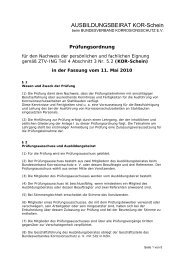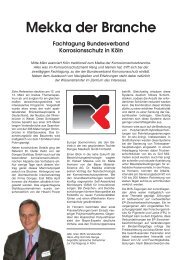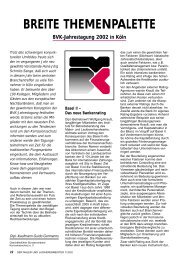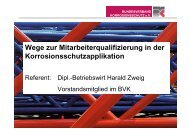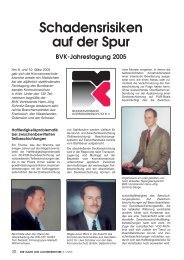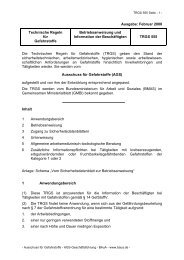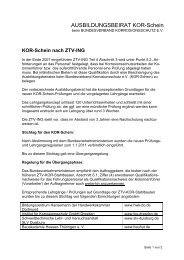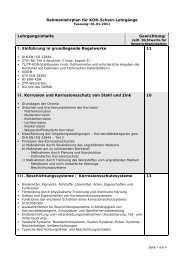Guideline of trade associations - VdL Verband der Lackindustrie e.V.
Guideline of trade associations - VdL Verband der Lackindustrie e.V.
Guideline of trade associations - VdL Verband der Lackindustrie e.V.
You also want an ePaper? Increase the reach of your titles
YUMPU automatically turns print PDFs into web optimized ePapers that Google loves.
To retard the possible formation <strong>of</strong> wet storage stain on the surface, articles that are not to<br />
be painted can be given a suitable surface treatment after hot dip galvanizing<br />
If the articles are to be painted or pow<strong>der</strong> coated after galvanizing, the purchaser should<br />
inform the galvanizer before the article is galvanized.<br />
9<br />
In addition, in the National Supplement to EN ISO 1461 attention is drawn to the following:<br />
Re: Annex A.2 - Abbreviations<br />
Coating DIN EN ISO 1461 – t Zn b as well as<br />
Coating DIN EN ISO 1461 – t Zn k.<br />
The abbreviation “t Zn b” means „Hot-dip galvanizing and paint coating“, the abbreviation “t<br />
Zn k” means hot-dip galvanizing and “no after-treatment to be carried out”.<br />
Re: Clause C.4 – After-treatment<br />
Normally, no after-treatment <strong>of</strong> zinc coatings is carried out. In the absence <strong>of</strong> particular<br />
agreements relating to this, it is up to the supplier whether and, if so, which type <strong>of</strong> aftertreament<br />
is chosen (abbreviation t Zn o). If hot-dip galvanized steel parts are intended to be<br />
painted afterwards, the attention <strong>of</strong> the galvanizing shop is to be drawn to this fact in or<strong>der</strong> to<br />
avoid measures by the shop which adversely affect the adhesion and the properties <strong>of</strong> the<br />
paint coating. In these cases the abbreviation “t Zn k” (no after-treatment) is to be used.<br />
It is recommendable to or<strong>der</strong> for duplex systems a zinc coating having the abbreviation „t Zn<br />
k“ so that no after-treatment is carried out in the galvanizing shop which adversely affects the<br />
adhesion <strong>of</strong> subsequent paint coatings.<br />
5.3 Coating materials / Paint coatings for duplex systems<br />
5.3.1 General notes: Liquid and pow<strong>der</strong> coating materials<br />
Paint coatings for duplex systems are obtained from liquid coating materials and pow<strong>der</strong><br />
coating materials <strong>of</strong> different bin<strong>der</strong> basis. In the technical frame <strong>of</strong> selected bin<strong>der</strong> basis<br />
they can be adapted to the methods <strong>of</strong> surface preparation and application as well as to the<br />
drying and curing conditions.<br />
Liquid Pow<strong>der</strong> Coating material<br />
Application Brushing, roller coating, Electrostatic<br />
spraying spraying<br />
Drying, Depending on type Thermal<br />
curing physically or curing by<br />
chemical reaction chemical reaction<br />
at 150 to 220 °C<br />
Coating<br />
(solid and firmly<br />
adhering)<br />
Whilst liquid coating materials are drying or curing at normal environmental conditions,<br />
pow<strong>der</strong> coating materials are to be principally cured thermally.<br />
Liquid coating materials for corrosion protection contain volatile matter (organic solvents and<br />
water). Pow<strong>der</strong> coating materials are applied in the form <strong>of</strong> a dry free-flowing pow<strong>der</strong> and<br />
practically contain no volatile matter.



